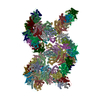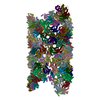+ データを開く
データを開く
- 基本情報
基本情報
| 登録情報 | データベース: PDB / ID: 9g3i | ||||||||||||||||||||||||||||||||||||||||||
|---|---|---|---|---|---|---|---|---|---|---|---|---|---|---|---|---|---|---|---|---|---|---|---|---|---|---|---|---|---|---|---|---|---|---|---|---|---|---|---|---|---|---|---|
| タイトル | Circularly permuted lumazine synthase twisted tube with 18 Angstrom gap between double strands | ||||||||||||||||||||||||||||||||||||||||||
 要素 要素 | 6,7-dimethyl-8-ribityllumazine synthase | ||||||||||||||||||||||||||||||||||||||||||
 キーワード キーワード | DE NOVO PROTEIN / protein cage / protein engineering / self-assembly / geometry / helical reconstruction / bionanotechnology / polymorphism / pentamer | ||||||||||||||||||||||||||||||||||||||||||
| 機能・相同性 |  機能・相同性情報 機能・相同性情報6,7-dimethyl-8-ribityllumazine synthase / 6,7-dimethyl-8-ribityllumazine synthase activity / riboflavin synthase complex / riboflavin biosynthetic process / cytoplasm / cytosol 類似検索 - 分子機能 | ||||||||||||||||||||||||||||||||||||||||||
| 生物種 |   Aquifex aeolicus VF5 (バクテリア) Aquifex aeolicus VF5 (バクテリア) | ||||||||||||||||||||||||||||||||||||||||||
| 手法 | 電子顕微鏡法 / らせん対称体再構成法 / クライオ電子顕微鏡法 / 解像度: 2.85 Å | ||||||||||||||||||||||||||||||||||||||||||
 データ登録者 データ登録者 | Koziej, L. / Azuma, Y. | ||||||||||||||||||||||||||||||||||||||||||
| 資金援助 |  ポーランド, European Union, 3件 ポーランド, European Union, 3件
| ||||||||||||||||||||||||||||||||||||||||||
 引用 引用 |  ジャーナル: ACS Nano / 年: 2025 ジャーナル: ACS Nano / 年: 2025タイトル: Dynamic Assembly of Pentamer-Based Protein Nanotubes. 著者: Lukasz Koziej / Farzad Fatehi / Marta Aleksejczuk / Matthew J Byrne / Jonathan G Heddle / Reidun Twarock / Yusuke Azuma /   要旨: Hollow proteinaceous particles are useful nanometric containers for delivery and catalysis. Understanding the molecular mechanisms and the geometrical theory behind the polymorphic protein assemblies ...Hollow proteinaceous particles are useful nanometric containers for delivery and catalysis. Understanding the molecular mechanisms and the geometrical theory behind the polymorphic protein assemblies provides a basis for designing ones with the desired morphology. As such, we found that a circularly permuted variant of a cage-forming enzyme, lumazine synthase, cpAaLS, assembles into a variety of hollow spherical and cylindrical structures in response to changes in ionic strength. Cryogenic electron microscopy revealed that these structures are composed entirely of pentameric subunits, and the dramatic cage-to-tube transformation is attributed to the moderately hindered 3-fold symmetry interaction and the imparted torsion angle of the building blocks, where both mechanisms are mediated by an α-helix domain that is untethered from the native position by circular permutation. Mathematical modeling suggests that the unique double- and triple-stranded helical arrangements of subunits are optimal tiling patterns, while different geometries should be possible by modulating the interaction angles of the pentagons. These structural insights into dynamic, pentamer-based protein cages and nanotubes afford guidelines for designing nanoarchitectures with customized morphology and assembly characteristics. | ||||||||||||||||||||||||||||||||||||||||||
| 履歴 |
|
- 構造の表示
構造の表示
| 構造ビューア | 分子:  Molmil Molmil Jmol/JSmol Jmol/JSmol |
|---|
- ダウンロードとリンク
ダウンロードとリンク
- ダウンロード
ダウンロード
| PDBx/mmCIF形式 |  9g3i.cif.gz 9g3i.cif.gz | 2.6 MB | 表示 |  PDBx/mmCIF形式 PDBx/mmCIF形式 |
|---|---|---|---|---|
| PDB形式 |  pdb9g3i.ent.gz pdb9g3i.ent.gz | 表示 |  PDB形式 PDB形式 | |
| PDBx/mmJSON形式 |  9g3i.json.gz 9g3i.json.gz | ツリー表示 |  PDBx/mmJSON形式 PDBx/mmJSON形式 | |
| その他 |  その他のダウンロード その他のダウンロード |
-検証レポート
| 文書・要旨 |  9g3i_validation.pdf.gz 9g3i_validation.pdf.gz | 999.9 KB | 表示 |  wwPDB検証レポート wwPDB検証レポート |
|---|---|---|---|---|
| 文書・詳細版 |  9g3i_full_validation.pdf.gz 9g3i_full_validation.pdf.gz | 1 MB | 表示 | |
| XML形式データ |  9g3i_validation.xml.gz 9g3i_validation.xml.gz | 234.5 KB | 表示 | |
| CIF形式データ |  9g3i_validation.cif.gz 9g3i_validation.cif.gz | 387.1 KB | 表示 | |
| アーカイブディレクトリ |  https://data.pdbj.org/pub/pdb/validation_reports/g3/9g3i https://data.pdbj.org/pub/pdb/validation_reports/g3/9g3i ftp://data.pdbj.org/pub/pdb/validation_reports/g3/9g3i ftp://data.pdbj.org/pub/pdb/validation_reports/g3/9g3i | HTTPS FTP |
-関連構造データ
| 関連構造データ |  51000MC  9g3hC  9g3jC  9g3mC  9g3nC  9g3oC  9g3pC M: このデータのモデリングに利用したマップデータ C: 同じ文献を引用 ( |
|---|---|
| 類似構造データ | 類似検索 - 機能・相同性  F&H 検索 F&H 検索 |
- リンク
リンク
- 集合体
集合体
| 登録構造単位 | 
|
|---|---|
| 1 |
|
- 要素
要素
| #1: タンパク質 | 分子量: 17465.934 Da / 分子数: 100 / 変異: 119 circular permutation,C37S,A85C / 由来タイプ: 組換発現 詳細: cpAaLS(119, C37S, A85C),cpAaLS(119, C37S, A85C),cpAaLS(119, C37S, A85C),cpAaLS(119, C37S, A85C) 由来: (組換発現)   Aquifex aeolicus VF5 (バクテリア) Aquifex aeolicus VF5 (バクテリア)遺伝子: ribH, aq_132 / 発現宿主:  参照: UniProt: O66529, 6,7-dimethyl-8-ribityllumazine synthase Has protein modification | N | |
|---|
-実験情報
-実験
| 実験 | 手法: 電子顕微鏡法 |
|---|---|
| EM実験 | 試料の集合状態: HELICAL ARRAY / 3次元再構成法: らせん対称体再構成法 |
- 試料調製
試料調製
| 構成要素 | 名称: Circularly permuted lumazine synthase twisted tube with 18 Angstrom gap between double strands タイプ: COMPLEX 詳細: Circularly permuted (119) variant of Aquifex aeolicus lumazine synthase with C37S and A85C mutations Entity ID: all / 由来: RECOMBINANT | ||||||||||||||||||||
|---|---|---|---|---|---|---|---|---|---|---|---|---|---|---|---|---|---|---|---|---|---|
| 分子量 | 値: 600 kDa/nm / 実験値: YES | ||||||||||||||||||||
| 由来(天然) | 生物種:   Aquifex aeolicus VF5 (バクテリア) Aquifex aeolicus VF5 (バクテリア) | ||||||||||||||||||||
| 由来(組換発現) | 生物種:  | ||||||||||||||||||||
| 緩衝液 | pH: 7 | ||||||||||||||||||||
| 緩衝液成分 |
| ||||||||||||||||||||
| 試料 | 濃度: 1 mg/ml / 包埋: NO / シャドウイング: NO / 染色: NO / 凍結: YES | ||||||||||||||||||||
| 試料支持 | グリッドの材料: COPPER / グリッドのサイズ: 200 divisions/in. / グリッドのタイプ: Quantifoil R2/2 | ||||||||||||||||||||
| 急速凍結 | 装置: FEI VITROBOT MARK IV / 凍結剤: ETHANE / 湿度: 100 % / 凍結前の試料温度: 283 K |
- 電子顕微鏡撮影
電子顕微鏡撮影
| 実験機器 |  モデル: Titan Krios / 画像提供: FEI Company |
|---|---|
| 顕微鏡 | モデル: TFS KRIOS |
| 電子銃 | 電子線源:  FIELD EMISSION GUN / 加速電圧: 300 kV / 照射モード: FLOOD BEAM FIELD EMISSION GUN / 加速電圧: 300 kV / 照射モード: FLOOD BEAM |
| 電子レンズ | モード: BRIGHT FIELD / 倍率(補正後): 105000 X / 最大 デフォーカス(公称値): 1500 nm / 最小 デフォーカス(公称値): 900 nm / Cs: 2.7 mm / C2レンズ絞り径: 50 µm / アライメント法: COMA FREE |
| 試料ホルダ | 凍結剤: NITROGEN 試料ホルダーモデル: FEI TITAN KRIOS AUTOGRID HOLDER |
| 撮影 | 電子線照射量: 42.44 e/Å2 フィルム・検出器のモデル: GATAN K3 BIOQUANTUM (6k x 4k) 撮影したグリッド数: 1 / 実像数: 12746 |
| 電子光学装置 | エネルギーフィルター名称: GIF Bioquantum / エネルギーフィルタースリット幅: 20 eV |
| 画像スキャン | 横: 5760 / 縦: 4092 |
- 解析
解析
| EMソフトウェア |
| |||||||||||||||||||||||||||||||||||||||||||||||||||||||
|---|---|---|---|---|---|---|---|---|---|---|---|---|---|---|---|---|---|---|---|---|---|---|---|---|---|---|---|---|---|---|---|---|---|---|---|---|---|---|---|---|---|---|---|---|---|---|---|---|---|---|---|---|---|---|---|---|
| CTF補正 | タイプ: PHASE FLIPPING AND AMPLITUDE CORRECTION | |||||||||||||||||||||||||||||||||||||||||||||||||||||||
| らせん対称 | 回転角度/サブユニット: 57.3 ° / 軸方向距離/サブユニット: 22.1 Å / らせん対称軸の対称性: C1 | |||||||||||||||||||||||||||||||||||||||||||||||||||||||
| 粒子像の選択 | 選択した粒子像数: 1620295 / 詳細: Filament tracing | |||||||||||||||||||||||||||||||||||||||||||||||||||||||
| 3次元再構成 | 解像度: 2.85 Å / 解像度の算出法: FSC 0.143 CUT-OFF / 粒子像の数: 807640 / アルゴリズム: FOURIER SPACE / クラス平均像の数: 4 / 対称性のタイプ: HELICAL | |||||||||||||||||||||||||||||||||||||||||||||||||||||||
| 原子モデル構築 | プロトコル: RIGID BODY FIT / 空間: REAL 詳細: Initial fitting was done using ChimeraX. Flexible fitting was done using Isolde. | |||||||||||||||||||||||||||||||||||||||||||||||||||||||
| 原子モデル構築 | PDB-ID: 1HQK Accession code: 1HQK / Source name: PDB / タイプ: experimental model |
 ムービー
ムービー コントローラー
コントローラー









 PDBj
PDBj

